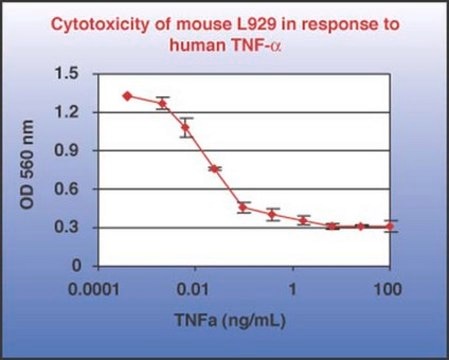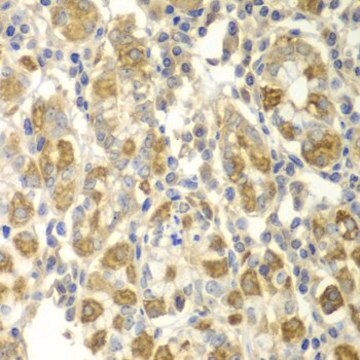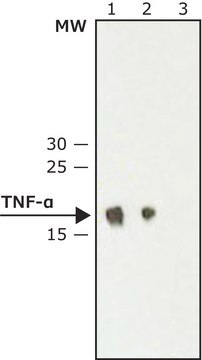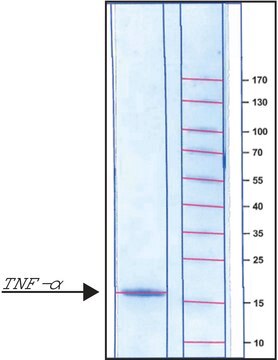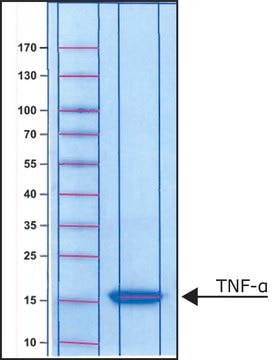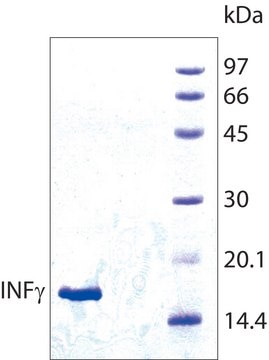654205-M
TNF-α, Human, Recombinant, E. coli
Synonym(s):
TNF-α, Human, Recombinant, E. coli, rhTNF-α, rh-Cachectin, Tumor Necrosis Factor-α
Sign Into View Organizational & Contract Pricing
All Photos(1)
About This Item
Recommended Products
recombinant
expressed in E. coli
Quality Level
assay
≥95% (SDS-PAGE)
form
lyophilized
manufacturer/tradename
Calbiochem®
storage condition
OK to freeze
impurities
≤0.1 ng/μg Endotoxin (ng/μg TNF-α)
storage temp.
−70°C
General description
Research area: Apoptosis
Tumor Necrosis Factor alpha (TNF α), a homotrimer protein made of 157 amino acids, is produced by macrophages/monocytes, T-lymphocytes, and natural killer cells during acute inflammation. soluble and transmembrane form. The precursor form of TNF-α is in transmembrane form (tmTNF-α), which is processed to release soluble form (sTNF-α).
Application
TNF-α, Human, Recombinant, E. coli has been used to stimulate NF-κB activation and study the effects of pancreatic elastase on cellular responses.
Biochem/physiol Actions
Recombinant, human tumor necrosis factor-α expressed in E. coli., a cytokine produced primarily by activated macrophages, activates a variety of immune defense mechanisms by interactions with polymorphonuclear leukocytes, T cells, antibody-producing B lymphocytes, fibroblasts, and hematopoietic bone marrow cells. Activity is not species-specific. Induces apoptosis in human blood and bone marrow neutrophils and in endothelial cells. Increases the iNOS levels in vascular smooth muscle cells. Involved in pathophysiological processes of several chronic and acute diseases. Stimulates stress-activated protein kinase (SAPK). ED₅₀ = 20-50 pg/ml as measured in a cytotoxicity assay with the TNF-α-susceptible murine L-929 cell line in the presence of Actinomycin D (Cat. No. 114666)
Tumor Necrosis Factor alpha (TNF alpha), is an inflammatory cytokine. It coordinates a range of signaling events within cells, leading to necrosis or apoptosis. TNF-α initiates signal transduction pathways by binding to TNFR-1 and TNFR-2. These pathways cause cellular processes such as cell survival, differentiation, and proliferation.
Warning
Toxicity: Standard Handling (A)
Reconstitution
Following reconstitution, aliquot and freeze (-20°C or -70°C) for long-term storage or refrigerate (4°C) for short-term storage. Avoid freeze/thaw cycles of solutions. Stock solutions are stable for up to 3 months at -20°C or -70°C or up to 1 month at 4°C.
Reconstitute with sterile, dH₂O to a final concentration of 0.1-1 mg/ml. Further dilutions should be made in low endotoxin medium or aqueous buffer containing carrier protein such as heat inactivated FCS or tissue culture grade BSA.
Other Notes
Merck Index 13, 9882.
Tsuchida, H., et al. 1995. J. Immunol. 154, 2403.
Westwick, J.K., et al. 1995. J. Biol. Chem. 270, 22689.
Polunovsky, V.A., et al. 1994. Exp. Cell Res.214, 584.
Koide, M., et al. 1993. FEBS Lett.318, 213.
Vilcek, J., and Lee, T.H. 1991. J. Biol. Chem.266, 7313.
Tsuchida, H., et al. 1995. J. Immunol. 154, 2403.
Westwick, J.K., et al. 1995. J. Biol. Chem. 270, 22689.
Polunovsky, V.A., et al. 1994. Exp. Cell Res.214, 584.
Koide, M., et al. 1993. FEBS Lett.318, 213.
Vilcek, J., and Lee, T.H. 1991. J. Biol. Chem.266, 7313.
Legal Information
CALBIOCHEM is a registered trademark of Merck KGaA, Darmstadt, Germany
Storage Class
12 - Non Combustible Liquids
wgk_germany
WGK 3
flash_point_f
Not applicable
flash_point_c
Not applicable
Certificates of Analysis (COA)
Search for Certificates of Analysis (COA) by entering the products Lot/Batch Number. Lot and Batch Numbers can be found on a product’s label following the words ‘Lot’ or ‘Batch’.
Already Own This Product?
Find documentation for the products that you have recently purchased in the Document Library.
Customers Also Viewed
Our team of scientists has experience in all areas of research including Life Science, Material Science, Chemical Synthesis, Chromatography, Analytical and many others.
Contact Technical Service

